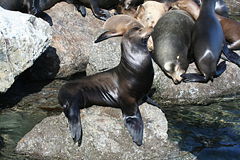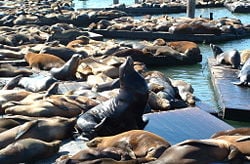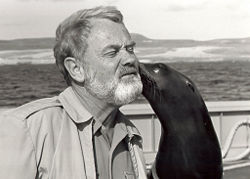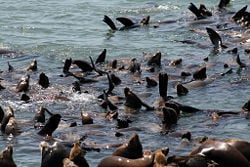Difference between revisions of "Sea lion" - New World Encyclopedia
Rick Swarts (talk | contribs) (Redirecting to Seal) |
Rick Swarts (talk | contribs) (added article from Wikipedia and credit/category tag) |
||
| Line 1: | Line 1: | ||
| − | + | {{common name for|Otariid|eared seals, including the [[fur seal]]s}} ''For other uses of the term "sea lion", see [[Sea lion (disambiguation)]].'' | |
| + | {{Taxobox | ||
| + | | name = Sea lion | ||
| + | | image = Sealion052006.JPG | ||
| + | | image_width = 240px | ||
| + | | image_caption = A sea lion in [[Monterey, California]] | ||
| + | | regnum = [[Animal]]ia | ||
| + | | phylum = [[Chordate|Chordata]] | ||
| + | | classis = [[Mammal|Mammalia]] | ||
| + | | ordo = [[Carnivora]] | ||
| + | | subordo = [[Pinniped]]ia | ||
| + | | familia = [[Otariidae]] | ||
| + | | familia_authority = in part | ||
| + | | subdivision_ranks = Genera | ||
| + | | subdivision = | ||
| + | ''[[Eumetopias]]''<br> | ||
| + | ''[[Zalophus]]''<br> | ||
| + | ''[[Otaria]]''<br> | ||
| + | ''[[Neophoca]]''<br> | ||
| + | ''[[Phocarctos]]'' | ||
| + | }} | ||
| + | |||
| + | [[Image:Sea Lion Headshot.JPG|250px|thumb|A resting Sea Lion in [[Galapagos National Park]], [[Ecuador]].]] | ||
| + | [[Image:Cal Sea Lions on Pier 39.JPG|250px|thumb|Hundreds of [[California Sea Lion]]s sunbathing on [[Pier 39]] in [[San Francisco]].]] | ||
| + | [[Image:GiGi sea lion 1984.jpg|250px|thumb|right|GiGi, a sea lion trained by the U.S. Navy for underwater recovery, nuzzles merchant mariner Capt. Arne Willehag of the USNS Sioux during a 1983 training session.]] | ||
| + | [[Image:Zalophus californianus at Moss Landing 3.jpg|250px|thumb|right|Sea Lions at [[Moss Landing]]]] | ||
| + | '''Sea lions''' are any of seven [[species]] in six [[genera]] of modern [[pinniped]]s including one extinct one (the [[Japanese sea lion]]). Sea lions are characterized by the presence of external ear [[pinna (anatomy)|pinnae]] or flaps, long front [[flipper (anatomy)|flippers]], and the ability to walk on four flippers on land. Their range extends from the [[subarctic]] to [[tropical]] waters of the [[global ocean]] in both the [[northern hemisphere|northern]] and [[southern hemisphere]]s with the notable exception of the [[Atlantic Ocean]]. They are generally found in shallow waters of coastal areas of both with abundant food resources.<ref>{{cite web |url=http://www.seaworld.org/animal-info/Animal-Bytes/animalia/eumetazoa/coelomates/deuterostomes/chordata/craniata/mammalia/pinnipedia/sea-lions-&-fur-seals.htm |title=ANIMAL BYTES - Sea Lions & Fur Seals |accessdate=2007-07-21}}</ref> | ||
| + | |||
| + | ==Taxonomy== | ||
| + | Together with the [[fur seal]], they comprise the [[Otariidae]] family, collectively known as eared seals. Until recently, sea lions were grouped under a single subfamily called ''Otariinae'' to distinguish them from the fur seals ''Arcocephalinae'', based on the most prominent common feature between all species, namely the lack of dense underfur characteristic of the latter. Recent genetic evidence, however, strongly suggests that the ''Callorhinus'', the genus of the [[Northern fur seal]] is more closely related to some sea lion species than to the fur seal genus ''Arctocephalus''.<ref> Wynen, L.P. et al. (2001) [http://dx.doi.org/10.1006/mpev.2001.1012 Phylogenetic relationships within the eared seals (Otariidae: Carnivora): implications for the historical biogeography of the family.] ''Mol. Phylog. Evol.'' 21, 270–284 </ref> Therefore the fur seal/sealion subfamily distinction has been largely eliminated. Nonetheless, all sea lions have certain features in common, in particular the coarse, short fur, greater bulk and larger prey than fur seals. | ||
| + | |||
| + | == Interactions with humans == | ||
| + | |||
| + | Some species of sea lions are readily trainable and are often a popular attraction at zoos and aquariums. The archetypal circus seal performing behaviors such as throwing and catching balls on its nose and clapping is almost always, in fact, a sea lion. | ||
| + | |||
| + | The government of Japan has set a quota of 116 kills per year in Hokkaido,{{Fact|date=June 2007}} as sea lions are seen as a threat to commercial [[fisheries]]. International environmentalists and local fishery advocates continue to debate the issue. | ||
| + | |||
| + | The Norwegian government has set a quota of 200 kills per year.{{Fact|date=June 2007}} | ||
| + | |||
| + | Sea lions have been trained by the [[U.S. Navy]]'s [[U.S. Navy Marine Mammal Program|Marine Mammal Program]], based in [[San Diego]], to detain [[scuba diver]]s.<ref>{{cite web | ||
| + | |url=http://news.yahoo.com/s/ap/20070213/ap_on_re_us/dolphin_defenders | ||
| + | |url=http://www.nbc11.com/news/11827003/detail.html?rss=bay&psp=news | ||
| + | |title=Navy may deploy anti-terrorism dolphins | ||
| + | |first=Thomas | ||
| + | |last=Watkins | ||
| + | |publisher=Associated Press | ||
| + | |date=2007-02-12 | ||
| + | |accessdate=2007-02-12}}</ref> | ||
| + | |||
| + | Sea lion attacks on humans are rare, but have occurred in at least a single notable case, in which a 13 year-old Australian girl was attacked while in the water. Sources said that the likeliest explanation was that the animal was attempting to play with the girl.<ref>[http://news.bbc.co.uk/1/hi/world/asia-pacific/6556895.stm BBC News: Sea lion attacks Australian girl]</ref><ref>[http://www.news.com.au/story/0,23599,21560487-2,00.html news.com.au: Monster sea lion likely to be 'playing' with teen]</ref><ref>[http://www.news.com.au/sundaymail/story/0,23739,21557673-953,00.html Sea lion mauls girl]</ref> | ||
| + | |||
| + | The [[Moche]] people of ancient [[Peru]] worshipped the sea and its animals. They often depicted sea lions in their art.<ref>Berrin, Katherine & Larco Museum. ''The Spirit of Ancient Peru:Treasures from the [[Larco_Museum|Museo Arqueológico Rafael Larco Herrera]].'' New York: [[Thames and Hudson]], 1997.</ref> | ||
| + | |||
| + | ==Species== | ||
| + | * '''''SUBORDER [[Pinnipedia|PINNIPEDIA]]''''' | ||
| + | * '''Family Otariidae''' | ||
| + | ** ''Genus [[Arctocephalus]]'' (southern fur seal species) | ||
| + | ** ''Genus [[Callorhinus]]'' (northern fur seal) | ||
| + | ** ''Genus Eumetopias'' | ||
| + | *** [[Steller Sea Lion]], ''E. jubatus'' | ||
| + | ** ''Genus Neophoca'' | ||
| + | *** [[Australian Sea Lion]], ''N. cinerea'' | ||
| + | ** ''Genus Otaria'' | ||
| + | *** [[South American Sea Lion]], ''O. flavescens'' | ||
| + | ** ''Genus Phocarctos'' | ||
| + | *** [[New Zealand Sea Lion]] or [[Hooker's Sea Lion]], ''P. hookeri'' | ||
| + | ** ''Genus Zalophus'' | ||
| + | *** [[California Sea Lion]], ''Z. californianus'' | ||
| + | *** [[Japanese Sea Lion]], ''Z. japonicus'' - [[extinct]] (1950s) | ||
| + | *** [[Galapagos Sea Lion]], ''Z. wollebaeki'' | ||
| + | * Family [[Phocidae]]: true seals | ||
| + | * Family [[Odobenidae]]: Walrus | ||
| + | |||
| + | ==Hybrids== | ||
| + | A hybrid sea lion from a cross between the California sea lion (''Zalophus californianus'') and the South American sea lion (''Otaria byronia'') has occurred.{{Fact|date=December 2007}} | ||
| + | |||
| + | ==References==<!-- ZOOLOGICAL SCIENCE 24: 81–85 (2007) —> | ||
| + | {{Reflist}} | ||
| + | |||
| + | ==See also== | ||
| + | *[[Otariids]] | ||
| + | *[[Pinniped]] | ||
| + | *[[Marine Mammal]] | ||
| + | |||
| + | ==External links== | ||
| + | * [http://www.visitingnewzealand.com/sealions-on-the-otago-peninsula-dunedin/ Video of Sea Lions on the Otago Peninsula, Dunedin, New Zealand] | ||
| + | |||
| + | {{Otariidae nav}} | ||
| + | |||
| + | [[Category:Life sciences]] | ||
| + | [[Category:Animals]] | ||
| + | [[Category:Mammals]] | ||
| + | |||
| + | {{credit|Sea_lion|222740448}} | ||
Revision as of 15:24, 4 July 2008
Template:Common name for For other uses of the term "sea lion", see Sea lion (disambiguation).
| Sea lion | ||||||||||||
|---|---|---|---|---|---|---|---|---|---|---|---|---|
 A sea lion in Monterey, California
| ||||||||||||
| Scientific classification | ||||||||||||
| ||||||||||||
|
Eumetopias |
Sea lions are any of seven species in six genera of modern pinnipeds including one extinct one (the Japanese sea lion). Sea lions are characterized by the presence of external ear pinnae or flaps, long front flippers, and the ability to walk on four flippers on land. Their range extends from the subarctic to tropical waters of the global ocean in both the northern and southern hemispheres with the notable exception of the Atlantic Ocean. They are generally found in shallow waters of coastal areas of both with abundant food resources.[1]
Taxonomy
Together with the fur seal, they comprise the Otariidae family, collectively known as eared seals. Until recently, sea lions were grouped under a single subfamily called Otariinae to distinguish them from the fur seals Arcocephalinae, based on the most prominent common feature between all species, namely the lack of dense underfur characteristic of the latter. Recent genetic evidence, however, strongly suggests that the Callorhinus, the genus of the Northern fur seal is more closely related to some sea lion species than to the fur seal genus Arctocephalus.[2] Therefore the fur seal/sealion subfamily distinction has been largely eliminated. Nonetheless, all sea lions have certain features in common, in particular the coarse, short fur, greater bulk and larger prey than fur seals.
Interactions with humans
Some species of sea lions are readily trainable and are often a popular attraction at zoos and aquariums. The archetypal circus seal performing behaviors such as throwing and catching balls on its nose and clapping is almost always, in fact, a sea lion.
The government of Japan has set a quota of 116 kills per year in Hokkaido,[citation needed] as sea lions are seen as a threat to commercial fisheries. International environmentalists and local fishery advocates continue to debate the issue.
The Norwegian government has set a quota of 200 kills per year.[citation needed]
Sea lions have been trained by the U.S. Navy's Marine Mammal Program, based in San Diego, to detain scuba divers.[3]
Sea lion attacks on humans are rare, but have occurred in at least a single notable case, in which a 13 year-old Australian girl was attacked while in the water. Sources said that the likeliest explanation was that the animal was attempting to play with the girl.[4][5][6]
The Moche people of ancient Peru worshipped the sea and its animals. They often depicted sea lions in their art.[7]
Species
- SUBORDER PINNIPEDIA
- Family Otariidae
- Genus Arctocephalus (southern fur seal species)
- Genus Callorhinus (northern fur seal)
- Genus Eumetopias
- Steller Sea Lion, E. jubatus
- Genus Neophoca
- Australian Sea Lion, N. cinerea
- Genus Otaria
- South American Sea Lion, O. flavescens
- Genus Phocarctos
- New Zealand Sea Lion or Hooker's Sea Lion, P. hookeri
- Genus Zalophus
- California Sea Lion, Z. californianus
- Japanese Sea Lion, Z. japonicus - extinct (1950s)
- Galapagos Sea Lion, Z. wollebaeki
- Family Phocidae: true seals
- Family Odobenidae: Walrus
Hybrids
A hybrid sea lion from a cross between the California sea lion (Zalophus californianus) and the South American sea lion (Otaria byronia) has occurred.[citation needed]
ReferencesISBN links support NWE through referral fees
- ↑ ANIMAL BYTES - Sea Lions & Fur Seals. Retrieved 2007-07-21.
- ↑ Wynen, L.P. et al. (2001) Phylogenetic relationships within the eared seals (Otariidae: Carnivora): implications for the historical biogeography of the family. Mol. Phylog. Evol. 21, 270–284
- ↑ Watkins, Thomas (2007-02-12). Navy may deploy anti-terrorism dolphins. Associated Press. Retrieved 2007-02-12.
- ↑ BBC News: Sea lion attacks Australian girl
- ↑ news.com.au: Monster sea lion likely to be 'playing' with teen
- ↑ Sea lion mauls girl
- ↑ Berrin, Katherine & Larco Museum. The Spirit of Ancient Peru:Treasures from the Museo Arqueológico Rafael Larco Herrera. New York: Thames and Hudson, 1997.
See also
- Otariids
- Pinniped
- Marine Mammal
External links
| ||||||||||||||
Credits
New World Encyclopedia writers and editors rewrote and completed the Wikipedia article in accordance with New World Encyclopedia standards. This article abides by terms of the Creative Commons CC-by-sa 3.0 License (CC-by-sa), which may be used and disseminated with proper attribution. Credit is due under the terms of this license that can reference both the New World Encyclopedia contributors and the selfless volunteer contributors of the Wikimedia Foundation. To cite this article click here for a list of acceptable citing formats.The history of earlier contributions by wikipedians is accessible to researchers here:
The history of this article since it was imported to New World Encyclopedia:
Note: Some restrictions may apply to use of individual images which are separately licensed.


